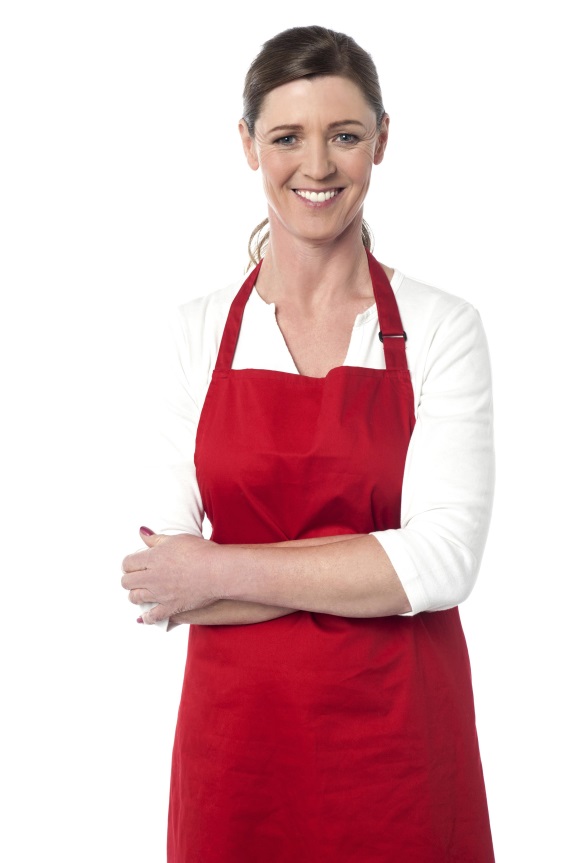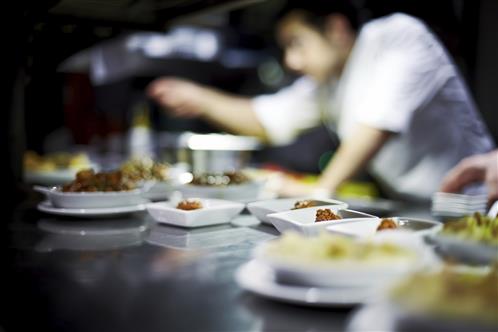A Guide to Holiday Food Safety for Restaurants & Caterers
During the holidays, restaurants and caterers are put to the test with a greater volume of activity and more pressure to move quickly. At the same time, food safety practices, like maintaining scrupulously clean company uniforms, should be top of mind for anyone handling, preparing, or serving food.
Restaurants and Caterers

Be extra vigilant about safety during this busy season when everyone up and down the line is likely to look for a shortcut here and there. Many establishments add temporary staff or permanent employees to cover the holiday rush, so take extra time to train new recruits and bring them up to speed on crucial food safety issues.
It’s hard to imagine a worse time than the extended holidays to find yourself sick in bed, or worse, in the hospital, recovering from dreaded food poisoning. In the United States alone, as many as 76 million cases of foodborne illness are recorded per year, costing millions of dollars.1
The U.S. Department of Agriculture (USDA) and the Food and Drug Administration (FDA), mandate strict HACCP, or hazard analysis and critical control points, for meat, seafood, and juice products. Many other food industries voluntarily apply the principles to fulfill their own specific government requirements, and to keep customers as well as workers safe.
Processors of these foods can avoid costly and dangerous contamination issues by fully training employees and monitoring implementation of the seven principles and guidelines.
HACCP Basic Principles2
Principle 1 – Conduct a hazard analysis.
Principle 2 – Determine the Critical Control Points (CCPs).
Principle 3 – Establish critical limits.
Principle 4 – Establish a monitoring system.
Principle 5 – Establish a procedure for corrective action when monitoring at a CCP indicates a deviation from an established critical limit.
Principle 6 – Establish procedures for verification to confirm the effectiveness of the HACCP plan.
Principle 7 – Establish documentation concerning all procedures and records appropriate to these principles and their application.
Using the HACCP protocol to establish and monitor strict guidelines is a proven way to minimize risk of illness and contamination. It is most effective when paired with rules that are specific to the catering or restaurant service industry.
Be sure your plan for food safety ensures good practices among all staff, from selection and intake of food, to kitchen maintenance, food preparation, and finally, food service and all contact with customers.
Concentrate on the most common sources of contamination first, namely, food supplier sources and your own staff, to eliminate the highest risk factors. Consistently remind staff of some of the most common sources of contamination, namely human hands and employee illness.
Employee Uniforms and Dress Code

Work wear, from chef uniforms to the bar-back’s apron, can present a great risk factor if not properly laundered and worn. Achieve the safest environment by ensuring that food preparation and service employees follow these guidelines:
Aprons, uniforms, and all garments are clean at the start of each shift.
No damaged or deteriorating uniforms or garments allowed (frayed edges and defects can trap harmful bacteria or endanger employees while handling equipment).
No pockets should be worn above the waist; avoid wearing jewelry.
Never wear uniforms or aprons outside food preparation and service areas.
A reliable uniform service, like Prudential Uniform Supply, can be a vital component in maintaining the best possible food safety principles. When sourcing a uniform supplier for the food industry, be sure the vendor lives up to appropriate standards with a range of HACCP product, to achieve the best possible clean process goals. Check to see that your source offers:
- The most suitable specialized garments for each job function.
- Portal-to-portal sanitation control.
- Verifiable processing methods.
- HACCP trained staff.
- Poly wrap delivery services.
Proper Hygiene for Food Service Staff
Review with staff the reasons and techniques they must maintain all sanitation guidelines, including individual, personal hygiene. Establish basic rules that supervisors can reinforce on a regular basis, including:
- Wash hands frequently with anti-bacterial soap, and certainly without fail every time food is touched (offer clear information on how to effectively, thoroughly wash hands).
- Wear disposable gloves when handling food.
- Use only disposable tissues to wipe or blow nose, and never while in the food prep area.
- Do not come to work or be in any food preparation and service areas if ill, sneezing, or coughing.3
Safe Food Handling Practices

You’ll establish a clean record of food service and vastly lower any risk of foodborne illness by following the above guidelines for personal hygiene. However, none of it matters if the key piece of the puzzle is missing, namely, making sure the food itself is safely handled from start to finish.
Train food handlers in observing the following rules:
- The Source: Know each supplier of fresh food, and ensure that their handling practices are impeccable.
- Equipment: Each type of food should be prepared on a different piece of equipment. The main food categories are raw meat, raw poultry or seafood, and produce. Separate cutting boards should be used for each, as well as separate sets of utensils.
- Sanitizing: Wash all items with soap and hot water after every task, then rinse and sanitize before next use.
- Refrigeration: Wrap all raw meats, seafood, and poultry in separate containers or sealed plastic bags before refrigerating. Be sure that no juices are leaking or dripping.
- Storage: Wrap all raw meats, seafood, and poultry in separate containers or sealed plastic bags before refrigerating. Be sure that no juices are leaking or dripping.
- Temperatures: Stay on top of refrigeration and heating temperatures so bacteria have no room to get comfortable. Government guidelines4 describe the “danger zone” as between 40 °F and 140 °F. Keep refrigeration at 40 °F or lower, freezers at 0 °F or lower, and maintain hot cooked food at 140 °F or higher.
Be confident that your employees are as careful and concerned as you are when it comes to food sanitation issues. Do your part by providing a controlled supply of clean, sanitary work clothes, and sail through the holiday season with a spotless grade in food safety.